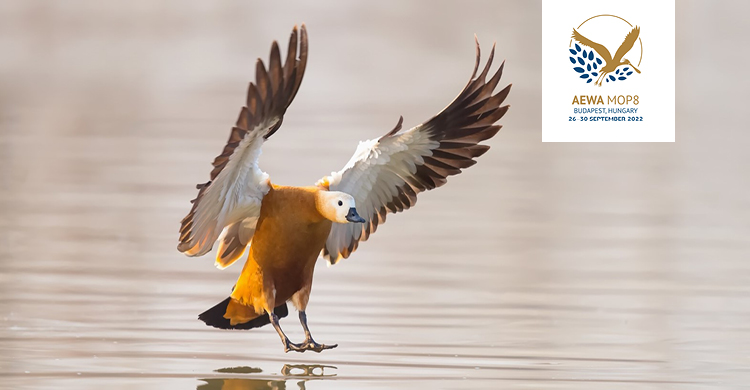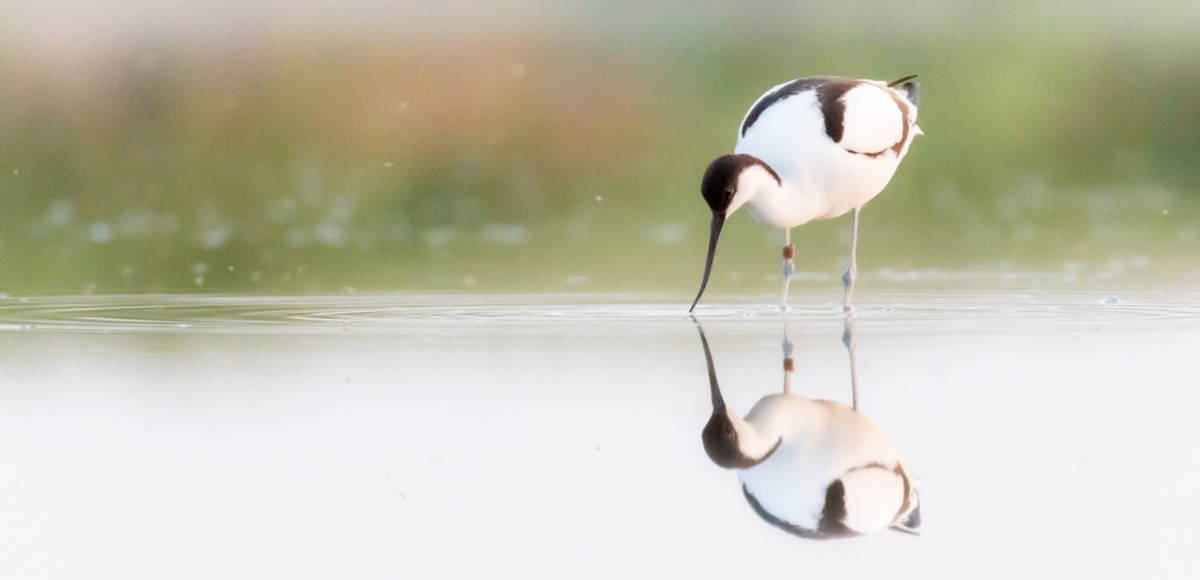Study Confirms: Migratory Waterbirds Require Well-managed Protected Areas

Ruddy shelduck (Tadorna ferruginea), one of the species included in the study. © Khalid Sharif
Budapest, 25 September 2022 - A study recently published earlier in 2022 in the journal Nature shows that the conservation impact of protected areas, such as national parks, on species greatly varies according to the way that they are managed.
The study led by the universities of Exeter and Cambridge examined the impact of 1,500 protected areas (in 68 countries) on more than 27,000 waterbird populations.
The study compared waterbird population trends in protected areas before management control with trends afterwards and compared the trends of similar waterbird populations inside and outside protected areas.
AEWA Executive Secretary Jacques Trouvilliez said: “The study is of high importance to AEWA, but also to future global biodiversity policy. The research shows that the quality of the management of a protected area plays an important role and that countries across the flyway need to ensure that the areas within their national jurisdiction are well-managed. In fact, they need to be managed in a species-focussed way so that they actually benefit biodiversity, including migratory waterbids.”
The research concentrated on waterbirds because they are well studied and can be found in many locations worldwide. The fact that many waterbirds migrate also means that they can quickly colonize or leave a location, which can be used as an indicator for the quality of the conditions at a given site.
The study shows that many protected areas are working well and that larger protected areas tend to be better than smaller ones, but also that many protected areas are failing to have a positive effect on species.
“We are not saying protected areas don’t work. The key point is that their impacts vary hugely, and the biggest thing this depends on is whether they are managed with species in mind – we can’t just expect protected areas to work without appropriate management,” said Dr. Hannah Wauchope, one of the lead authors of the study at Exeter University in Cornwall, UK.
Ruff (Calidrix pugnax), one of the species included in the study. © Matti Saranpää
Relevance to Global Biodiversity Policy
The study has direct implications for global biodiversity policy and the Global Post-2020 Biodiversity Framework discussions around a possible 30% by 2030 target on protected areas. In fact, the authors argue that the future biodiversity targets should include targets that will improve the quality of protected areas and not just a proportion of the Earth’s surface.
The Global Biodiversity Framework is being negotiated under the Convention on Biological Diversity (CBD) and will set the agenda for global conservation efforts for the next decade. Although postponed due to the pandemic, the international conference set to adopt the new framework is now due to be held in Montreal, Canada later this year.
“The message to world leaders meeting in Montreal later this year is clear. It is not enough to agree on protecting a given percentage of the Earth’s surface by 2030. Governments will also need to set targets that will measurably improve the quality of protected areas, not just the quantity,“ said Trouvilliez.
According to the authors of the study, future biodiversity targets should focus on creating and supporting well-managed protected areas that will measurably benefit waterbird populations and other wildlife. It also shows that the research being done with existing long-term waterbird monitoring data could become key in global efforts to measure the quality and impact of conservation efforts being carried out in key areas in a country and across a range of countries.
Importance to AEWA
The study is also relevant to ongoing developments under AEWA aiming at strengthening the delivery against the provisions of the treaty regarding the conservation and management of the flyway site network .
Objective 3 of the AEWA Strategic Plan 2019-2027 calls on AEWA Parties “To establish and sustain a coherent and comprehensive flyway network of protected areas and other sites, managed to maintain – and where necessary restore – their national and international importance for migratory waterbird populations.”
“The findings presented in the study are closely linked to the provisions of AEWA regarding site conservation and management and also support the objectives outlined in the AEWA Strategic Plan 2019 – 2027,” said Sergey Dereliev, Head of AEWA Secretariat’s Science, Implementation and Compliance Unit.
Migratory waterbirds are particularly vulnerable because they migrate over long distances and are dependent on networks of wetlands that are decreasing in extent and becoming degraded through unsustainable human activities.
“The protection of key sites, such as wetlands, individually and collectively as flyway networks is a key component of the AEWA conservation strategy for migratory waterbirds both at national and flyway level,” said Dereliev.
The ultimate conservation goal of AEWA is to maintain or restore waterbird populations to a favourable conservation status, which heavily relies on protecting waterbird habitats, reducing disturbances and avoiding their unsustainable exploitation. Site protection, including efforts to manage and conserve protected areas, are an important component in all of these efforts.
One of the actions listed in AEWA’s Strategic Plan 2019 – 2027 calls upon Parties to review and confirm an inventory of the known nationally and internationally important sites for waterbirds protected under AEWA in their territory. For this reason, Contracting Parties to AEWA have been asked to submit their national site inventories to the AEWA Secretariat by MOP8. While more than 40% of the Parties submitted their inventories, the work will continue in the months following MOP8 for fully completing this initial step under the first target of AEWA’s Strategic Plan Objective 3.
AEWA’s Strategic Plan also foresees the establishment of an AEWA site monitoring framework that will facilitate the assessment of the status of, the threats to, and the effectiveness of conservation measures implemented at flyway network sites. A proposal for such a site monitoring framework was developed in 2021 and has now been submitted for adoption by the 8th AEWA Meeting of the Parties (AEWA MOP8). Having this framework adopted at MOP8 will be a precondition for the timely and comprehensive implementation under Objective 3 of AEWA’s Strategic Plan.
“This paper is a reminder of the importance of establishing a simple, but effective framework under AEWA which will help us , amongst other things, improve site management in ways that will clearly benefit migratory waterbirds and other species alike,” said Trouvilliez.

Pied avocet (Recurvirostra avocetta), one of the species included in the study. © Robert Blanken
Last updated on 19 December 2022


